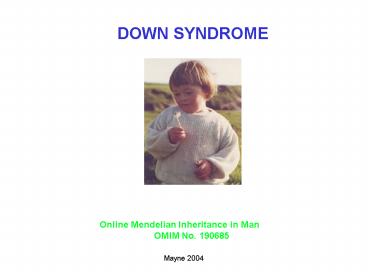DOWN SYNDROME - PowerPoint PPT Presentation
1 / 18
Title:
DOWN SYNDROME
Description:
TRISOMY 21 = Down Syndrome. Only three trisomies are compatible with. post-natal survival. Trisomy 13. Trisomy 18. Trisomy 21. Trisomy 21 is the most common ... – PowerPoint PPT presentation
Number of Views:5764
Avg rating:3.0/5.0
Title: DOWN SYNDROME
1
DOWN SYNDROME
Online Mendelian Inheritance in Man
OMIM No. 190685
2
www.ncbi.nlm.nih.gov/Omim
3
CORE TEXT Essential Reading
1 copy in Reserve Collection 9 copies on
Short Loan RB 155 Tho
4
AUTOSOMAL DISORDER Abnormality
of the autosomal chromosomes
5
Normal Karyotype
Down Syndrome Karyotype
6
KARYOTYPE 47, XX21
7
TRISOMY 21 Down Syndrome Only three trisomies
are compatible with post-natal survival Trisomy
13 Trisomy 18 Trisomy 21 Trisomy 21 is the
most common chromosome abnormality disorder in
man.
8
Described in 1866 by Langdon Down
- Phenotype
- Abnornormal appearance at birth, hypotonia
- Dysmorphic facial features
- - Flat nasal bridge, low set ears, epicanthal
folds
9
(No Transcript)
10
- Phenotype
- Abnornormal appearance at birth, hypotonia
- Dysmorphic facial features
- - Flat nasal bridge, low set ears, epicanthal
folds - Moderate mental retardation
- IQ 30-60 (Normal 100)
- Frequent congenital malformations
- In particular, heart and GI tract problems
- 10-20 fold increased risk of leukemia
- 90 have a significant loss of hearing
- Early on-set of Alzheimers Disease (Dementia)
- But, happy and socially responsive children
11
Incidence
Age related - Risk increases with maternal
age Under 20 1/1250 at birth Risk begins to
rise after age 30 45 yrs and over 1/25 live
births However, birth rate does not take
account of foetal loss or elective abortion
following prenatal diagnosis
12
5 of DS patients are not Trisomic for Chr. 21,
but have other chromosome abnormalities. 4
of DS patients have 46 chromosomes with
a Additional chr. 21 material permanently
attached to another chromosome. eg.
Robertsonian translocation. Usually
translocation between Chr. 21 and
either Chr. 14 or 22
http//www.irn.pdx.edu/newmanl/Robertsonian.gif
13
http//www.irn.pdx.edu/newmanl/Robertsonian.gif
14
(No Transcript)
15
http//www.irn.pdx.edu/newmanl/Robertsonian.gif
16
46 XY,-14,t(14q21q). A karyotype of a male Down
syndrome child with a Robertsonian translocation
involving chromosomes 14 and 21. This individual
has three chromosomes 21, one of which is
permanently attached to chromosome
14. www.nas.com/ downsyn/benke.html
17
Trisomy 21
Translocation DS
18
Need to know Basics - working
knowledge of How changes in DNA can lead to
disease DNA Gene Relationship DNA and
proteins How changes in DNA lead to disease
phenotypes What are chromosomes and their
relationship to disease? Relationship between
DNA and chromosomes Terminology of
chromosomes Meiosis Prenatal
diagnosis Ultra-sound Amniocentesis Chorioni
c villus sampling Indications for
PND Biochemical tests































